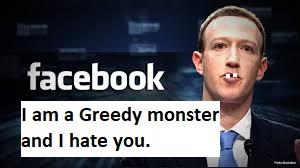How Facebook makes ad revenue by intentionally making you angry and sick to your stomach.

If you’re scrolling through Facebook and see a post that’s not from a friend, it’s fake. Every article, every page, every heart-tugging photo—100% fabricated.
Remember those viral stories about Connie Francis’s funeral that flooded feeds a while back? Total lies, churned out by Meta users inventing news to grab clicks.
That “man saves kittens from a low flying eagle” post with a cute photo? Fake. The photo’s probably AI-generated or stolen and formatted to fit a fake narrative are made up to rile you up.
Facebook isn’t just letting this happen—it’s making bank on it, and it’s tearing apart real human connection in the process.
Let’s break it down. Facebook’s algorithm thrives on engagement—likes, shares, comments, especially angry ones. Meta users, not some shadowy cabal, are behind the fakery. They create pages with names like “Patriot News Now” or “Heartwarming Stories Daily,” pumping out articles that sound real but aren’t.
These aren’t journalists; they’re opportunists gaming the system for ad revenue. A 2021 study from the Center for Countering Digital Hate found that fake news pages on Facebook generate millions in ad profits annually, with Meta pocketing a cut.
That Connie Francis funeral hoax? It wasn’t one post—it was dozens, spread across fake pages, each racking up clicks before anyone checked if she was even alive (she was, as of 2023).The goal isn’t just money—it’s division.
Whether you’re left wing, right wing, or just trying to live your life, your feed is flooded with stories crafted to make you mad.
A post about a politician’s “scandal”? Fake. A heartwarming tale of a kid saving a puppy? Fake. The algorithm doesn’t care about truth; it wants you arguing with strangers in the comments. Remember those posts claiming a celebrity died in a bizarre accident? They’re designed to spark outrage or tears, keeping you hooked.
A 2022 MIT study showed that false information spreads six times faster than truth on social media, and Facebook’s design amplifies this.
It’s not about informing you—it’s about turning your emotions into cash. This fakery kills wholesome communication. Real people—friends, family—used to share updates, photos, memories on Facebook. Now, your feed’s a minefield of lies, drowning out the good stuff.
Strangers fight over fake stories, like whether a politician said something awful or a kitten was saved from an eagle. It doesn’t matter if you lean left or right; the stories are tailored to push your buttons.
A 2020 report from Avaaz found that fake news pages reached over 100 million users monthly, sowing discord on everything from politics to public health. Facebook could crack down, but why would they? Every click, every fight, means more ad views.
Here’s the fix: Click “Not Interested” on every story, every time. Doesn’t matter if you agree with it or if it makes you smile—it’s fake. That “veteran rescues dog from flood” post? Made up. The photo’s probably not even real—AI can whip up convincing images in seconds. Clicking “Not Interested” tells the algorithm to stop feeding you lies. It’s not perfect, but it’s a start. Better yet, stick to posts from actual friends—real people sharing real moments. That’s what Facebook was supposed to be.
The Connie Francis hoaxes showed how far this goes. Pages claimed she died in every way imaginable, and people believed it, shared it, fought over it. Meanwhile, Celine Dion was not at her funeral — neither was Bill Gates, Elton John, Tom Hanks, etc etc. – and the truth didn’t matter.
Facebook’s a machine built to divide us, and it’s working. Stop feeding it. Click “Not Interested.” Talk to your friends. Reclaim the platform for what’s real or just leave it to rot like MySpace – a site that had the dignity to die young.



